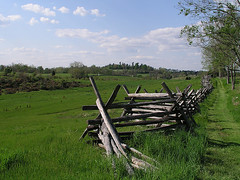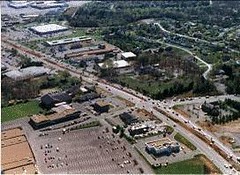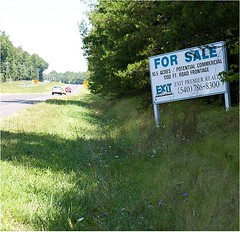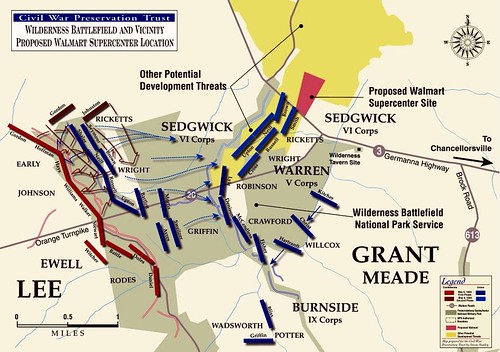Saving history from sprawl: threats to Civil War battlefields

Posted December 4, 2008 at 2:17PM
Several years ago, when we were researching and outlining Solving Sprawl, my co-author Jutka Terris advocated strongly for the inclusion of the example of using conservation easements on private land to protect Maryland's historic Antietam battlefield from sprawl development.  Nancy Vorsanger and I agreed, because Jutka had found a great success story, and today citizens can witness nearly the entire, sobering 8,000-acre site where 23,000 Americans were killed or wounded in a single day. The easements supplement the core 3,250 acres in the Antietam National Battlefield Park, already owned and managed by the National Park Service.
Nancy Vorsanger and I agreed, because Jutka had found a great success story, and today citizens can witness nearly the entire, sobering 8,000-acre site where 23,000 Americans were killed or wounded in a single day. The easements supplement the core 3,250 acres in the Antietam National Battlefield Park, already owned and managed by the National Park Service.
As Jutka wrote in our book, the state of Maryland's conservation action saved the historic site from the indignity of encroachment by additional subdivisions with names such as "Confederate Hills" and "Battlefield Knolls," to name two already built near the battlefield. The state was able to access funds from Maryland's Enhancements program under federal transportation legislation and from the newly-created (at the time) Rural Heritage Program. Participation in the easement program was entirely voluntary, but nearly all of the landowners agreed.
 That success, unfortunately, has not been replicated nearly enough. In a richly detailed story ("McMansionizing History") in The Washington Post's Sunday magazine, John A. Farrell writes:
That success, unfortunately, has not been replicated nearly enough. In a richly detailed story ("McMansionizing History") in The Washington Post's Sunday magazine, John A. Farrell writes:
"For a century after the Civil War, there was little cause to fret about its battlegrounds. In recent decades, that has changed. Entire battlefields have been lost to sprawl in Franklin, Tenn., and Atlanta. From the red clay around Richmond, developments with names such as Stonewall Estates have sprouted where Lee stopped the Union drive to capture the Confederate capital in 1862. Even the historic vistas at Antietam and Gettysburg have been put at risk, as the tendrils of exurban Washington creep into Western Maryland and southern Pennsylvania. In 1997, the federal government's Civil War Sites Advisory Commission published an updated survey of 384 'principal' battlegrounds and warned: 'This nation's Civil War heritage is in grave danger. It is disappearing under buildings, parking lots, and highways. We may lose fully two-thirds of the principal battlefields.'
"'I will give you an example,' [Jim] Lighthizer says. 'You know about Pickett's Charge? It was a charge by 13,000 men, more or less, across a mile of open ground, supported by artillery, attacking a wall. What do you know about the Battle of Franklin? Well, it was an attack by 25,000 men -- twice the number -- over two miles of open ground, with no artillery support against a heavily fortified line, with significantly more casualties.
"'And you know why most people haven't heard about Franklin? Because they paved it over.'"
 Lighthizer is president of the Civil War Preservation Trust. Go to the organization's website and you will learn that Walmart is looking to build a 141,000-square-foot Supercenter right next to The Wilderness Battlefield in Orange County, Virginia.
Lighthizer is president of the Civil War Preservation Trust. Go to the organization's website and you will learn that Walmart is looking to build a 141,000-square-foot Supercenter right next to The Wilderness Battlefield in Orange County, Virginia.
The Battle of the Wilderness, fought in early May 1864, was one of the largest and most important battles of the Civil War. It marked the first clash between legendary Civil War generals Robert E. Lee and Ulysses S. Grant. For two days, more than 160,000 (!) men were engaged in the struggle at the Wilderness. The see-saw battle culminated in attacks that first had the Confederate Army, then their Union counterparts, teetering on the edge of destruction. As the Trust's website notes, "when the guns fell silent on the evening of May 6, nearly 29,000 Americans had been killed, wounded or captured."
In the map above, the area in green is the currently preserved portion of the Fredericksburg-Spotsylvania National Battlefield. The area in yellow, where the map notes the location of several sectors of Union troops during the fighting, is in private hands and subject to development. The proposed Walmart site is in red.
Threats to Civil War battlefields (and other important sites) led the National Trust for Historic Preservation to declare the 175-mile "Journey Through Hallowed Ground" corridor stretching from Gettysburg to Monticello as one of the nation's eleven most endangered historic places in 2005. The National Trust has noted:
"This once-tranquil landscape is being radically transformed by suburban sprawl from the fast-growing DC metropolitan area where new
subdivisions sprout in the midst of cornfields, meandering country roads are straightened and widened to accommodate traffic, traditional 'Main Street' towns find their character threatened by incompatible new development, and venerable landmarks are engulfed by sprawl."
The effort to preserve key sites within the corridor has led to the formation of a public-private education and advocacy partnership, which had a hand in stopping a proposed casino from being built at Gettysburg (!) and which successfully advocated the designation of the corridor as a National Heritage Area, which will make annual funding available for education and heritage tourism. In addition, the corridor is the subject of a recent book published by the National Geographic Society. Preservation advocacy within the corridor is also a focus of Virginia's well-regarded Piedmont Environmental Council.
They and the Civil War Preservation Trust have their work cut out for them. In addition to the Walmart fight at the Wilderness Battlefield, a 2-million-square-foot commercial development is reportedly being proposed adjacent to the Harpers Ferry National Historical Park in West Virginia. Several more challenges are recounted in Farrell's article in the Post. Let's wish them well.
